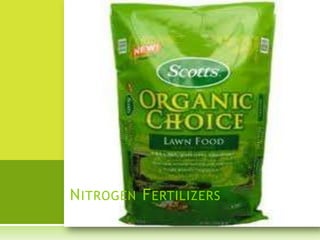
Nitrogen fertilizer1
- 1. N ITROGEN F ERTILIZERS
- 2. T YPES O F N ITROGEN F ERTILIZERS Organic nitrogen – This is found in decaying animals and plant materials. They are slow-acting but they supply nitrogen for a longer period. Inorganic nitrogen – This can be either ammonium or nitrate. In the form of ammonium, it bonds tightly with the soil particles, so it moves through the soil to plants more slowly. In the form of nitrate, plants can quickly and easily absorb nitrogen, but it leaches, or is washed, from the soil quickly.
- 3. I NORGANIC Nitrate fertilizers (NO3- ): Nitrogen present in these fertilizers are in nitrate form, NO3 - which are rapidly dissociated to release NO3-ions and readily absorbed by the plants. They are alkaline in their residual effect in soil. Ammonium fertilizers (NH4+): Ammonium fertilizers are soluble in water and, as such, absorbed on the soil colloids and thus protected from being washed away by run off or by leaching. The absorbed ammonium ions on soil collections are transformed to nitrate slowly and taken up by most of the crops. They are acidic in their residual effect in soil. Nitrate and Ammonium fertilizers (Nitrate, NO3- and ammonium, NH4+ ): These fertilizers contain nitrogen in both nitrate (NO3- ) and ammonium forms (NH4+ ). They are soluble in water and suitable for most of the crops and soils. They are acidic in its residual effect.
- 4. O RGANIC Amide Fertilizers (Amine, NH2 or amide, CN2): These fertilizers contains nitrogen in organic compounds as amide—NH2 or ---- CN 2 , not directly available to plants, as such , but quickly converted by soil microbes to ammonia cal and nitrate form and then utilized. Slow release nitrogenous fertilizers: These are newly developed fertilizers which release nitrogen in soil very slowly so that it may be available to the plants for longer period of time. Use of these materials result in better utilization of applied nitrogen by the growing crop plants and reduce losses.
- 5. N ITROGEN CYCLE
- 6. P ROCESS OF THE E XTRACTION OF N ITROGEN Nitrogen may be prepared from air by passing the air through a solution of caustic soda to remove carbon dioxide. 2 NaOH + CO2 ==> Na2CO3 + H2O Then the gas stream is passed over heated copper turnings which removes the oxygen. Cu + O2 ==> 2 CuO However, when nitrogen is prepared by this method, the gas is somewhat impure due to the presence of traces of the inert Nobel Gases, which are also present in the atmosphere. Nitrogen may also be prepared by the decomposition of compounds containing nitrogen. For example, nitrogen gas is liberated on heating a dilute solution of ammonium nitrite. NH4NO2 ==> N2 + 2 H2O
- 7. A DVANTAGES O F N ITROGEN F ERTILIZERS • Works immediately Inorganic fertilizers are usually given as a “rescue treatment” to plants that are malnourished, unhealthy or even dying. Inorganic fertilizers are appropriate in this situation because the nutrients needed by the plants are readily available. In comparison, using an organic fertilizer would mean that the plant has to wait until the components of the organic fertilizer have been broken down first into its primary nutrients. By then, the plant could be dead already. • Affordable You do not have to spend much on buying an inorganic fertilizer because it is relatively cheap. Of course, it is not as cost-effective when compared to using compost. Yet, for the convenience that it gives you when it comes to caring for your plants, an inorganic fertilizer is a very good deal already.
- 8. D ISADVANTAGES O F N ITROGEN F ERTILIZERS • Accumulation of toxic wastes Inorganic fertilizers are not entirely composed of the nutrients needed by the plants. It also contains salts and other compounds. These are not absorbed by the plants so they are left behind in the soil and build up over time. When found in large amounts in the soils, these compounds can alter the chemistry of the soil that makes it less ideal for planting. Often times, the soil needs to be neutralized using other substances to return it to a normal state that is suitable for planting. Furthermore, these toxic compounds may also get washed away when you water your plants and seep into groundwater. It has been reported that the toxic wastes from fertilizers contaminating the water we drink is bad for the health. • Too much is not a good thing Fertilizers are good sources of nutrients for plants. However, too much of it can also be harmful to the plants. Applying the fertilizer directly to the plants may burn the delicate plant structures such as the roots. This could affect the over-all development of the plant.
- 9. B ENEFITS Fertilizers are used to maintain the correct level of nitrogen in the soil, ensuring strong, green plants with a healthy growth rate. Nitrogen fertilizers can be used on a wide range of flora, from the household garden to commercial crops. They are currently used in one- third of the world's total crop production, including species such as maize, barley and soybean. Nitrogen fertilizers are also extensively used on commercial lawns, including a large proportion of the world's golf courses.